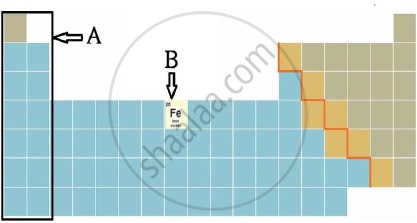Advertisements
Advertisements
प्रश्न
iii) Observe the figure and answer the following questions.
a) Identify the block shown by box A and write an electronic configuration of any one element of this block.
b) Identify the block of element denoted by letter B and write its period number.
उत्तर
a) The block shown by box A is s-Block.
S(16) = 2, 8, 6 (electronic configuration of any element in s block)
b) The block of element denoted by letter B is d – Block.
The period number of that element is 4.
APPEARS IN
संबंधित प्रश्न
Arrange the following as per the instruction given in the bracket.
Cs, Na, Li, K, Rb (increasing order of metallic character).
Arrange the following as per the instructions given in the brackets:
Na, K, Cl, S, Si (increasing order ionization energy)
Give the trend in metallic character:
(i) across the period left to right
Name the periodic property which relates to the character of element which loses one or more electrons when supplied with energy.
Arrange the elements of group 17 and group 1 according to the given conditions.
Increasing non – metallic character
Complete the following sentences
Moving across a ………….. of the periodic table the elements show increasing ………………..character (group, period, metallic, non-metallic).
Choose the correct answer.
An alkaline earth metal
(i) Lead
(ii) potassium
(iii) calcium
(iv) Copper
Among the elements of the second period, Li to Ne, pick out the element that is the most reactive metal
For the main group of the periodic table, the metallic properties of the elements vary approximately with their position as shown in the table.
| 1 | 2 | 3 | 4 | 5 | 6 | 7 | 8 |
| H | He | ||||||
| A | B | ||||||
| C | D |
Will the most metallic element be found at A,B,C or D ?
State whether the following statement is true or false
All members of zero group are non metals.
Explain
Group 17 elements are non-metals, while group 1 elements are metals.
Use the information given in (a) to (h) to identify the substances P to W selecting your answers from the given list.
List:
| Calcium | Oxygen | Copper (II) Oxide |
| Carbon | Calcium hydroxide | Copper (II) Nitrate |
| Lead (II) Oxide | Hydrogen chloride | Chlorine |
| Lead (II) Nitrate | Calcium Oxide | Ammonium chloride |
- P is white solid. When heated produces white fumes (sublime).
- P and R on warming produce an alkaline gas.
- On adding water to T, heat is evolved and R is formed.
- Q burns brightly in the air to form T.
- When S is heated, it gives off brown fumes and leaves a black residue of U.
- A solution of S is formed by warming U with dilute nitric acid.
- V is a gaseous non-metallic element that reacts with hydrogen to form W.
- A solution of W will neutralize the solution of R.
The tendency of an element to form anion is the ______ character of that element.
Write the name.
Two elements having two orbits.
Write an Explanation.
Electronegativity
Write scientific reason.
The non-metallic character increases while going from left to right in a period.
Choose the odd one out and write the reason:
Metals are good ______ because they are electron ______.
